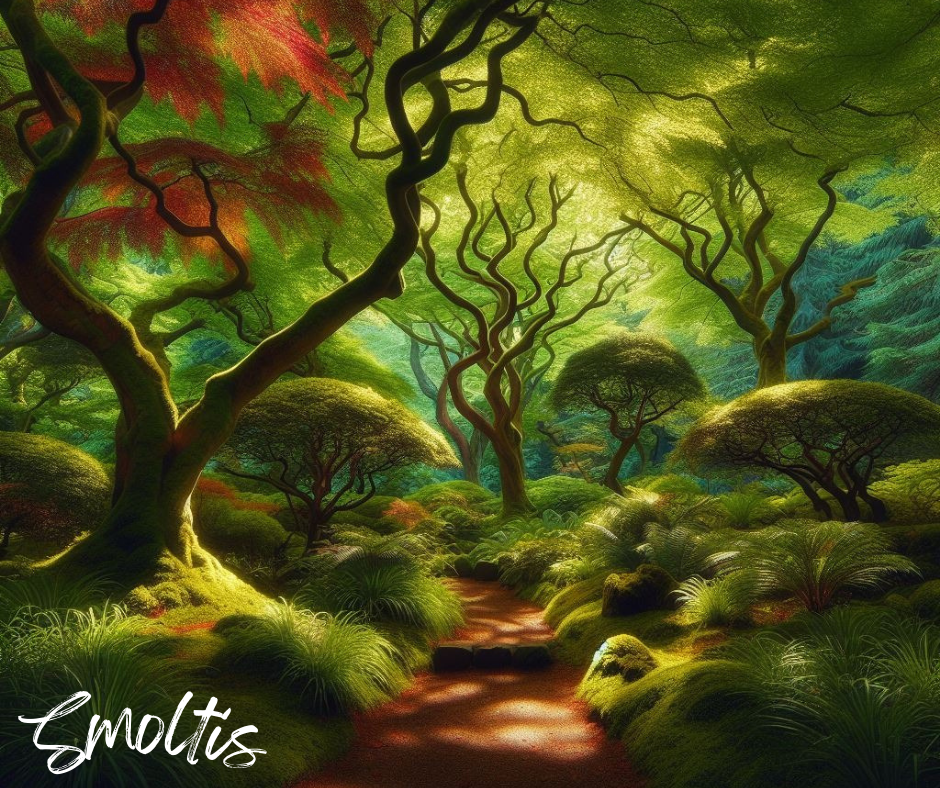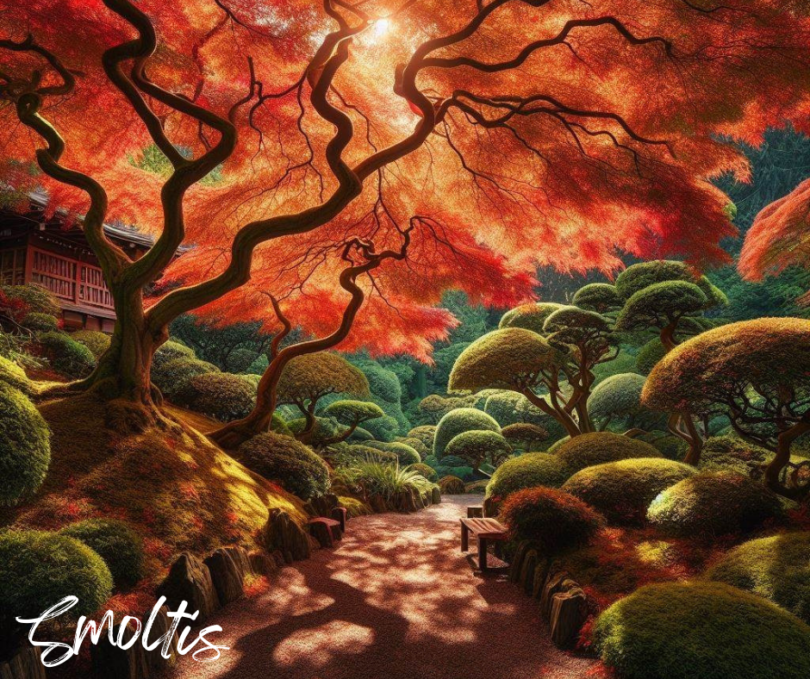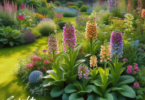Japanese maples are a group of small, ornamental trees known for their vibrant fall foliage and graceful, sculptural forms. These trees are highly valued in landscape design for their ability to provide natural shade and UV protection. With their diverse range of cultivars and growth habits, Japanese maples can be strategically incorporated into gardens and outdoor living spaces to create areas of cool, dappled shade that offer respite from the sun’s harsh rays. This article will explore the beauty, benefits, and best practices for growing Japanese maples as shade trees to enhance the aesthetic and functional aspects of any landscape.

Key Takeaways
- Japanese maples offer natural shade and UV protection in outdoor living spaces.
- These ornamental trees come in a wide range of cultivars with diverse leaf colors and growth habits.
- Strategically placing Japanese maples in the landscape can create cool, dappled shade areas.
- Japanese maples can help reduce the risk of sunburn and skin cancer by blocking harmful UV radiation.
- Proper care and maintenance are essential for the long-term health and appearance of Japanese maples in shaded conditions.
Introduction to Japanese Maples
Japanese maples (Acer palmatum) are a species of small, deciduous trees native to Japan, Korea, and China. These ornamental trees have been cultivated for centuries, prized for their stunning foliage and elegant growth habits. Over time, numerous cultivars have been developed, resulting in a wide range of leaf shapes, colors, and growth patterns.
History and Origins
Japanese maples have a rich history, dating back centuries in their native regions. These trees have long been revered for their beauty and symbolism, with their graceful forms and vibrant autumn hues becoming deeply embedded in Japanese culture and art. The cultivation and selective breeding of Japanese maples have led to the development of a diverse array of cultivars, each with unique characteristics that cater to the preferences of landscape designers, horticulturists, and gardening enthusiasts.
Varieties and Cultivars
From the iconic red-leafed varieties to the more subtle green and variegated forms, Japanese maples offer a diverse palette of options for landscapers and homeowners to choose from when incorporating these trees into their outdoor spaces. The range of cultivars includes both upright and weeping growth habits, as well as a variety of leaf shapes, from delicate lace-like patterns to bold, deeply lobed foliage. This diversity allows for versatile integration of Japanese maples into a wide array of landscape design schemes, catering to the unique preferences and needs of gardeners and horticulturists.
The Beauty of Japanese Maples
The true allure of Japanese maples lies in their exceptional ornamental qualities. During the fall season, these japanese maples transform into a breathtaking display of vibrant colors, ranging from deep reds and purples to brilliant oranges and yellows. The delicate, lace-like leaves flutter and dance in the breeze, creating a captivating visual spectacle.
Vibrant Fall Colors
The fall foliage of Japanese maples is one of their most captivating features. As the days grow shorter and the temperatures begin to cool, these ornamental trees burst forth with a stunning array of hues that rivals the most vibrant autumnal landscapes. From the deep crimson of the ‘Bloodgood’ cultivar to the golden shades of the ‘Aureum’ variety, each Japanese maple offers a unique seasonal show that enchants onlookers.
Graceful Foliage and Form
Beyond their seasonal splendor, Japanese maples are also prized for their elegant, sculptural forms. Their graceful, sweeping branches and varied growth habits, from upright to weeping, make them striking focal points in any landscape design. The delicate, lace-like foliage of these trees adds an ethereal quality to the garden aesthetics, creating a sense of movement and tranquility that captivates the viewer.
Shade and Sun Protection
Japanese maples are highly valued for their ability to provide natural shade and sun protection. The dense, spreading canopy of these trees can create cool, dappled areas that offer respite from the sun’s harsh rays. This shade can be particularly beneficial in outdoor living spaces, offering a reprieve from direct sunlight and reducing the risk of sunburn and UV exposure.
Benefits of Shaded Areas
By strategically placing Japanese maples in the landscape, homeowners can create shaded oases that promote skin cancer prevention and overall sun safety, reducing the need for artificial sun-blocking measures. The natural sunscreens provided by these trees can be a valuable complement to other sun protection strategies, creating a comprehensive approach to protecting against the harmful effects of prolonged sun exposure.
Reducing UV Exposure
The dense canopy of Japanese maples can effectively block and filter out harmful UV radiation, providing a natural and sustainable solution for creating shaded areas in outdoor living spaces. This sun protection can be especially beneficial for individuals and families who spend a significant amount of time outdoors, helping to mitigate the risks associated with excessive sun exposure and skin cancer.
Planting Japanese Maples for Shade
When incorporating Japanese maples into a landscape design for the purpose of providing shade, it is important to carefully consider the specific variety and its growth characteristics. Different Japanese maple cultivars can vary in their mature size, canopy spread, and leaf color, so choosing the right tree for the desired shade coverage and aesthetic is crucial.
Selecting the Right Variety
Homeowners and landscape designers should research the various Japanese maple cultivars to find the best fit for their needs. Factors such as maximum height, spread, and foliage hues should be taken into account to ensure the selected tree will provide the necessary shade while complementing the overall landscape design. Consulting with local nurseries or horticulture experts can help guide the selection process and ensure the chosen Japanese maple will thrive in the specific growing conditions.
Optimal Planting Locations
The optimal planting location for Japanese maples should balance the tree’s sun and moisture requirements, ensuring it will thrive in the shaded conditions. These ornamental trees prefer partial shade, with protection from direct afternoon sunlight, and well-drained, nutrient-rich soil. By strategically placing Japanese maples in locations that offer the right balance of sun exposure and soil conditions, homeowners can create the perfect environment for these shade-providing trees to flourish.
Soil and Watering Requirements
Maintaining the health and longevity of Japanese maples in a shaded landscape requires attentive care, particularly when it comes to soil and watering needs. These trees prefer well-drained, acidic soil that is rich in organic matter. Consistent, moderate watering is essential, especially during the establishment phase and periods of drought, to prevent stress and ensure the development of a robust, spreading canopy capable of casting effective shade. By providing the appropriate soil conditions and maintaining a consistent watering regimen, homeowners can help their Japanese maples thrive and continue to serve as reliable shade trees for years to come.
Pruning and Maintenance
Proper pruning and ongoing maintenance are essential for maintaining the health and aesthetic appeal of Japanese maples, especially when they are being used as shade trees. Careful, selective pruning can help shape the tree’s form, promote air circulation, and ensure the development of a robust, well-balanced canopy. Additionally, regular monitoring for pests and diseases, as well as timely watering and fertilization, can help keep Japanese maples thriving in their shaded environments, ensuring they continue to provide the desired level of sun protection.
Pruning Japanese maples should be done with a light touch, focusing on removing any dead, damaged, or crossing branches to maintain the tree’s natural, graceful form. This process helps to improve air flow, reduce the risk of disease, and encourage the development of a strong, balanced structure that can effectively cast shade. Regular inspections for common pests and diseases, such as aphids, scale insects, or fungal infections, are also crucial for keeping Japanese maples healthy and vibrant in their garden care environment.
Proper watering and fertilization are additional essential elements of Japanese maple maintenance. These trees thrive in consistently moist, well-drained soil and may require more frequent watering, especially during periods of drought or when planted in shaded areas. Applying a balanced, slow-release horticulture fertilizer can help support the tree’s nutrient needs and promote robust growth, ensuring it continues to provide the desired level of sun protection for years to come.
Shade and Skin Cancer Prevention
The shade provided by Japanese maples can play a significant role in promoting skin cancer prevention and overall sun safety. By creating shaded areas in outdoor living spaces, these trees can reduce the risk of harmful UV exposure and sunburn, which are major contributors to the development of skin cancer, including the deadly form, melanoma. Additionally, the natural shade offered by Japanese maples can serve as a complementary measure to the use of sunscreen, hats, and other sun-blocking strategies, further enhancing overall sun safety and melanoma awareness.
Importance of Sun Safety
Exposure to the sun’s harmful ultraviolet (UV) rays is a leading cause of skin cancer, including the most serious form, melanoma. By providing natural shade, Japanese maples can help mitigate the risk of sun exposure and subsequent skin damage, playing a crucial role in skin cancer prevention. This shade can offer a respite from the sun’s rays, allowing individuals to enjoy the outdoors while reducing their vulnerability to UV-related health issues.
Natural Sunscreens and Melanoma Awareness
While the use of sunscreen and other sun-blocking measures is essential, the shade cast by Japanese maples can serve as a complementary form of sun protection. By strategically placing these trees in outdoor living spaces, homeowners can create shaded areas that reduce the need for artificial sunscreens and enhance overall melanoma awareness. This integrated approach to sun safety promotes a well-rounded and effective strategy for protecting against the harmful effects of UV radiation.
Incorporating Japanese Maples into Landscape Design
When designing a landscape that incorporates Japanese maples as shade trees, it is important to consider the complementary plants and features that can enhance the overall aesthetics and functionality of the space. The strategic placement of these ornamental trees can create a harmonious and visually appealing outdoor environment.
Complimentary Plants for Shade Gardens
Shade-loving perennials, ferns, and ground covers can thrive beneath the dappled canopy of Japanese maples, creating a lush, layered effect that complements the trees’ graceful forms. Plants such as hostas, astilbes, and epimediums can add texture and color, while evergreen groundcovers like pachysandra and vinca can provide year-round ground coverage. By carefully selecting companion plants that flourish in the shaded conditions, landscapers can craft captivating shade gardens that showcase the beauty of Japanese maples.
Creating Outdoor Living Spaces
The strategic placement of seating areas, patios, and other outdoor living spaces can capitalize on the cool, shaded environments provided by Japanese maples, transforming the landscape into a true oasis of respite and relaxation. By situating these functional elements within the dappled shade of the trees, homeowners can create inviting spaces for entertaining, dining, or simply enjoying the serene ambiance. The combination of Japanese maples’ ornamental appeal and the practical benefits of their shade creates a harmonious synthesis of form and function, elevating the overall aesthetic and livability of the outdoor living space.
Caring for Japanese Maples in Shaded Conditions
While Japanese maples thrive in the cool, dappled shade they provide, proper care and maintenance are still essential to ensure their long-term health and vigor. One of the key considerations is monitoring the soil moisture levels, as these ornamental trees can be sensitive to both over-watering and drought conditions.
Monitoring Soil Moisture
Adapting the watering schedule to the specific microclimate created by the shaded environment is crucial. The reduced sunlight and evaporation rates in these areas can lead to soil remaining moist for longer periods, increasing the risk of root rot or other moisture-related issues. Regularly checking the soil moisture and adjusting the irrigation plan accordingly will help prevent these problems and keep the Japanese maples thriving in their shaded habitat.
Protecting from Pests and Diseases
In addition to monitoring soil moisture, vigilance in identifying and addressing any pest infestations or disease problems is necessary to protect the Japanese maples and maintain their ornamental appeal in the shaded landscape. Common pests and diseases that may affect these trees in shaded conditions include aphids, scale insects, and fungal diseases like leaf scorch or anthracnose. Regular inspections and proactive treatment measures can help safeguard the health and horticultural integrity of the Japanese maples in their shaded environment.
Conclusion
Japanese maples stand out as exceptional ornamental trees that offer both aesthetic and functional benefits when incorporated into landscape designs. Their ability to provide natural shade and UV protection make them invaluable for creating cool, comfortable outdoor living spaces and promoting skin cancer prevention. By carefully selecting the right cultivars, strategically placing them in the landscape, and maintaining their health, homeowners and landscape designers can leverage the unique qualities of Japanese maples to transform their outdoor areas into tranquil, shaded oases that enhance the overall beauty and functionality of the space.
The diverse range of Japanese maples allows for a wide variety of options when it comes to landscape design. From vibrant red-leafed varieties to more subtle green and variegated forms, these ornamental trees can be strategically incorporated to create visually stunning focal points and provide much-needed sun protection in any outdoor setting. By prioritizing the strategic placement and proper care of Japanese maples, homeowners and designers can create functional and aesthetically pleasing gardens that promote skin health and overall well-being.
As the benefits of shade and sun protection become increasingly recognized, the role of Japanese maples in landscape design will continue to grow in importance. By embracing these versatile and captivating trees, homeowners and landscape professionals can transform their outdoor spaces into tranquil, sun-shielded oases that not only delight the senses but also contribute to the health and safety of those who enjoy them.
FAQ
What are the benefits of Japanese maples for providing shade?
Japanese maples are highly valued for their ability to provide natural shade and sun protection. The dense, spreading canopy of these trees can create cool, dappled areas that offer respite from the sun’s harsh rays. This shade can be particularly beneficial in outdoor living spaces, offering a reprieve from direct sunlight and reducing the risk of sunburn and UV exposure.
How do Japanese maples help in skin cancer prevention?
The shade provided by Japanese maples can play a significant role in promoting skin cancer prevention and overall sun safety. By creating shaded areas in outdoor living spaces, these trees can reduce the risk of harmful UV exposure and sunburn, which are major contributors to the development of skin cancer, including the deadly form, melanoma. The natural shade offered by Japanese maples can serve as a complementary measure to the use of sunscreen, hats, and other sun-blocking strategies, further enhancing overall sun safety and melanoma awareness.
What should be considered when selecting and planting Japanese maples for shade?
When incorporating Japanese maples into a landscape design for the purpose of providing shade, it is important to carefully consider the specific variety and its growth characteristics. Different cultivars can vary in mature size, canopy spread, and leaf color, so choosing the right tree for the desired shade coverage and aesthetic is crucial. Additionally, the optimal planting location should balance the tree’s sun and moisture requirements, ensuring it thrives in the shaded conditions. Well-drained, nutrient-rich soil and consistent watering are essential for the health and longevity of Japanese maples, allowing them to develop the strong, spreading canopy needed to cast effective shade.
How do you maintain Japanese maples in shaded conditions?
While Japanese maples thrive in shaded conditions, proper care and maintenance are still essential to ensure their long-term health and vigor. Monitoring soil moisture levels is crucial, as these trees can be sensitive to both over-watering and drought. Adapting watering schedules to the specific microclimate created by the shaded environment can help prevent root rot or other moisture-related issues. Additionally, vigilance in identifying and addressing any pest infestations or disease problems is necessary to protect the trees and maintain their ornamental appeal in the shaded landscape.
What are some complementary plants that can be used with Japanese maples in a shade garden?
When designing a landscape that incorporates Japanese maples as shade trees, it is important to consider the complementary plants and features that can enhance the overall aesthetics and functionality of the space. Shade-loving perennials, ferns, and ground covers can create a lush, layered effect beneath the dappled canopy of the Japanese maples.







